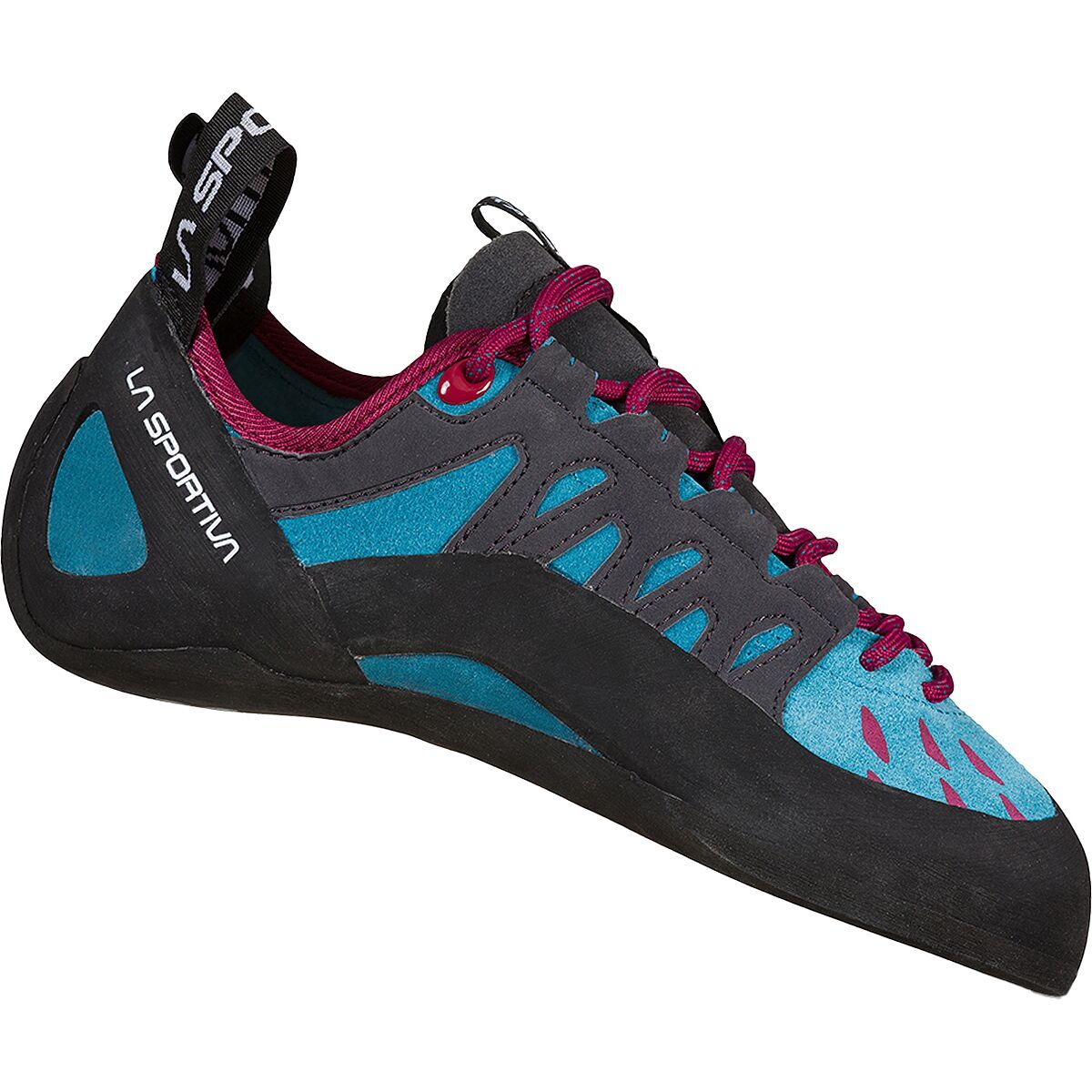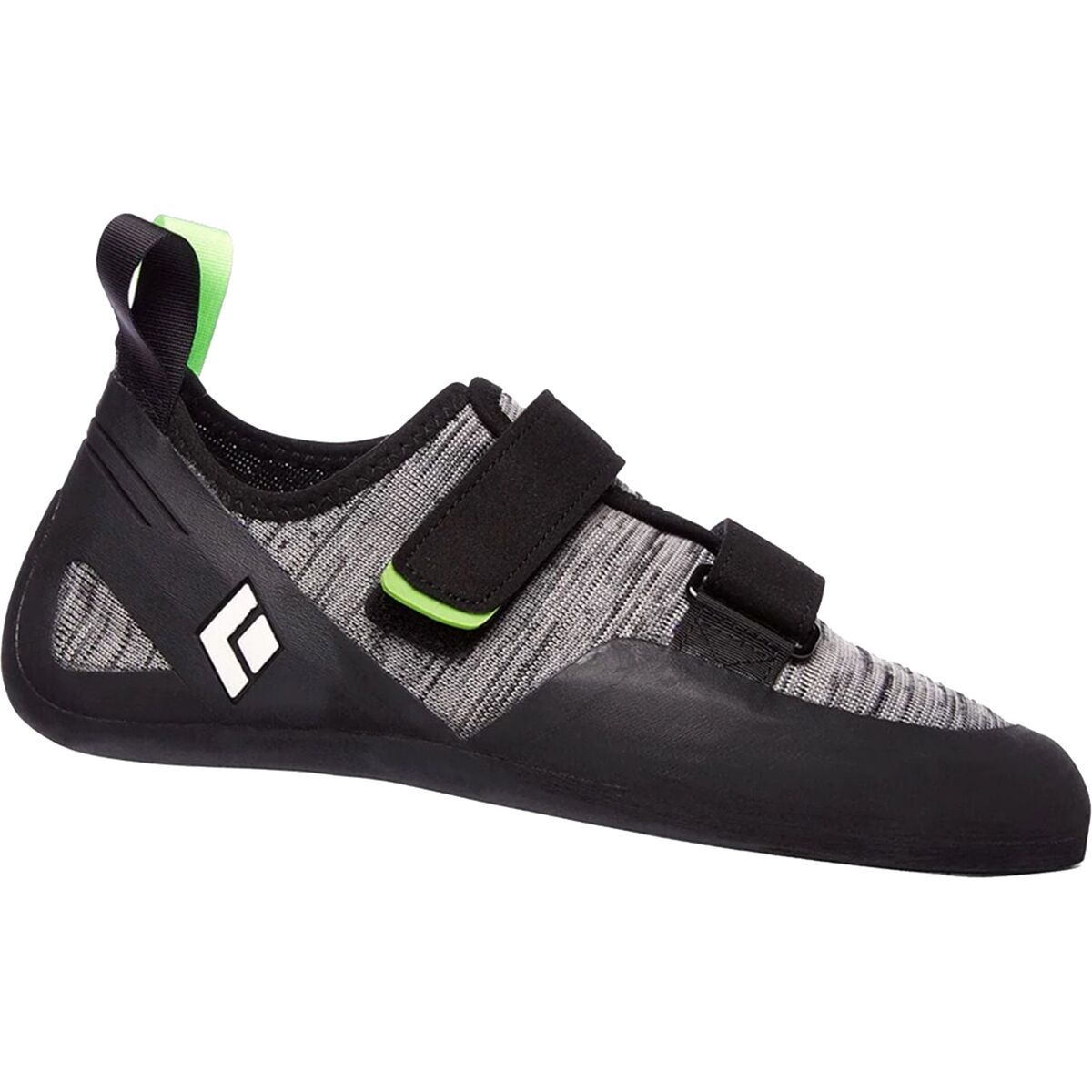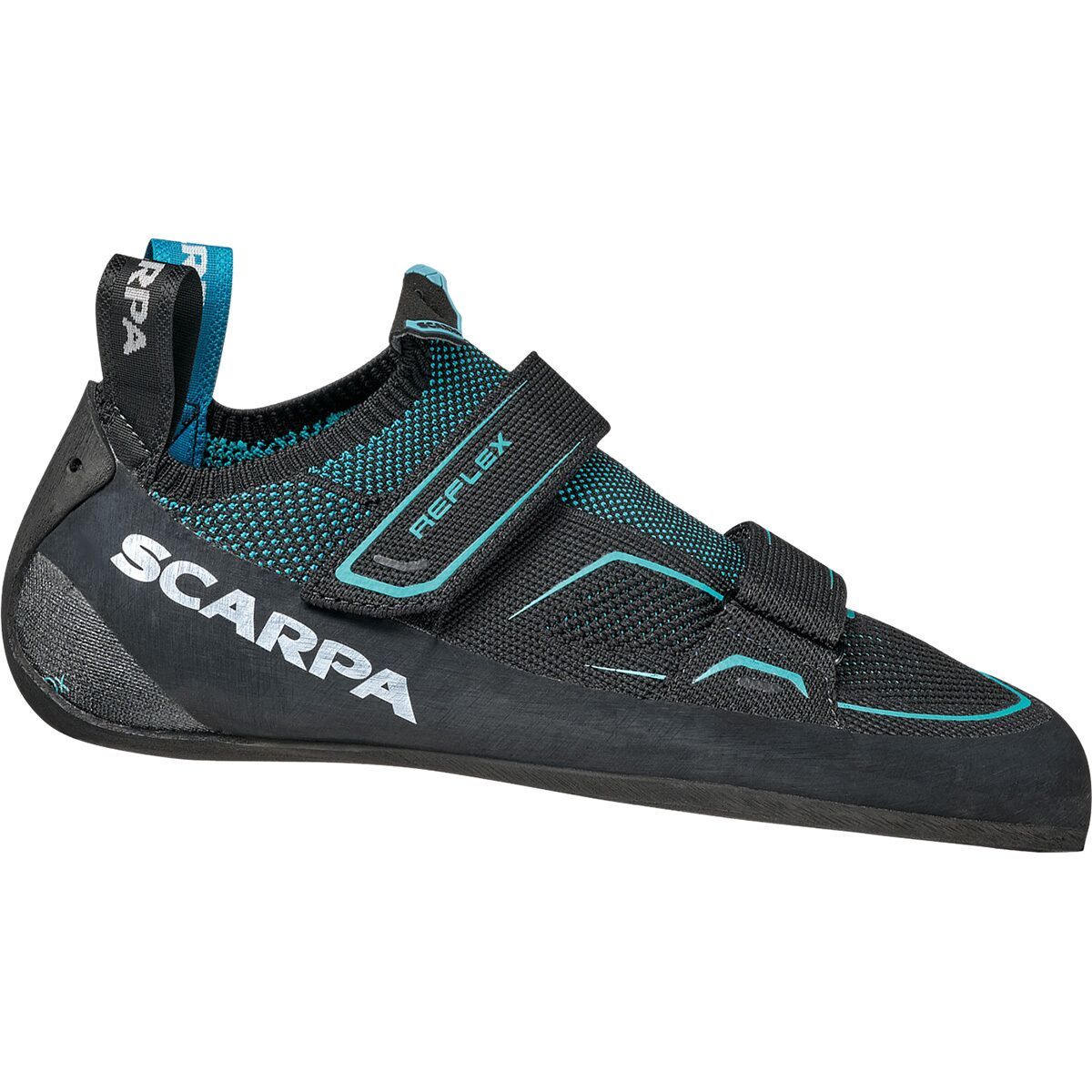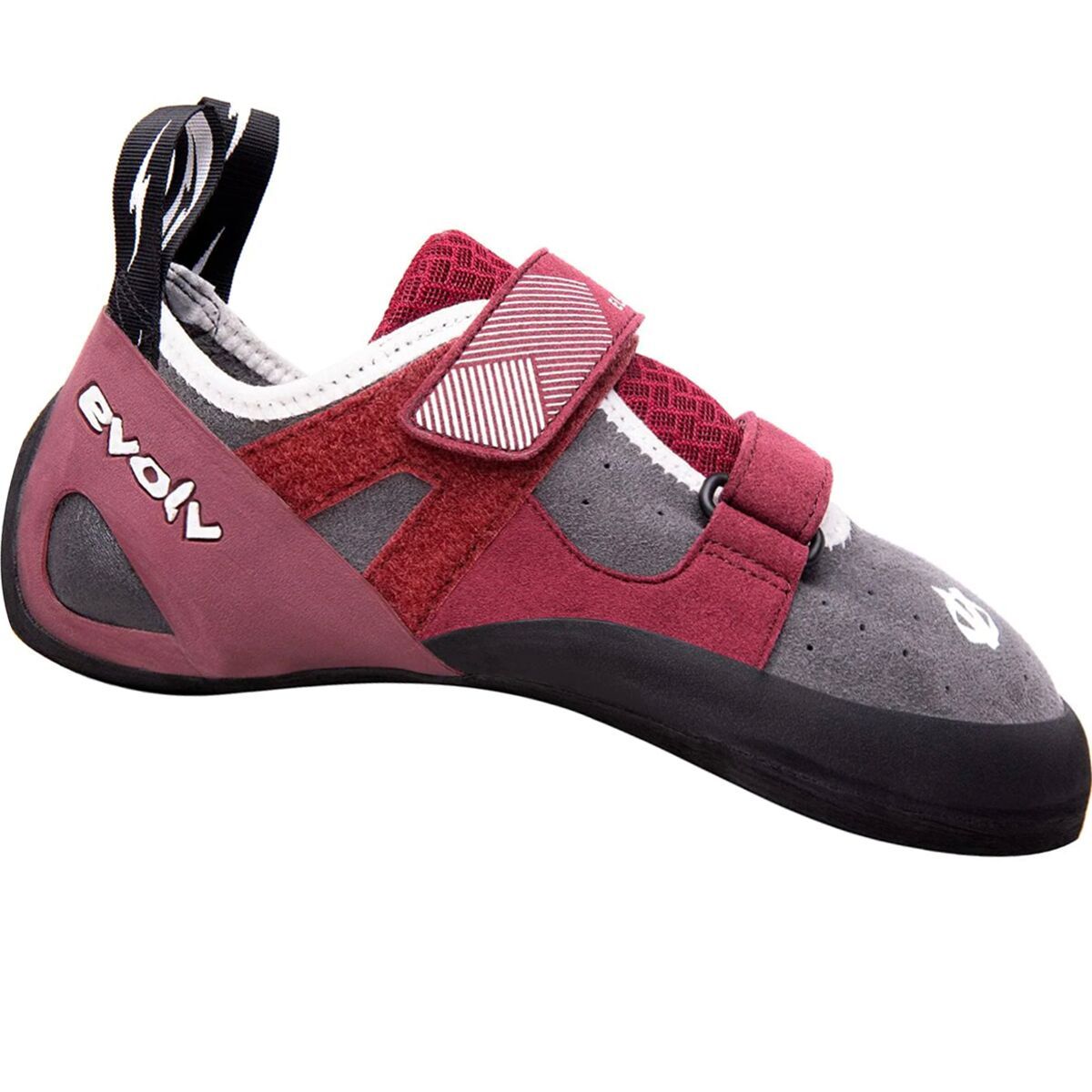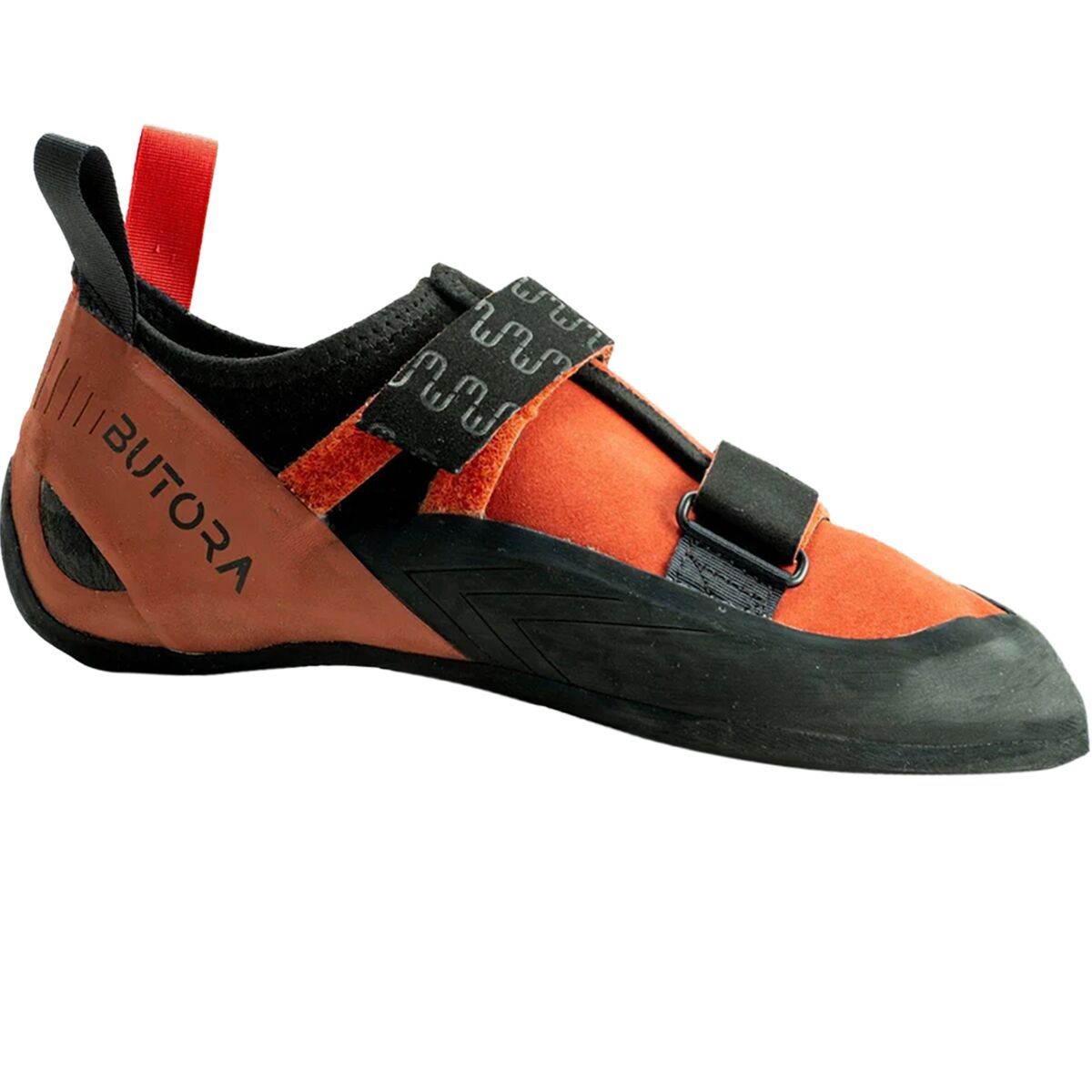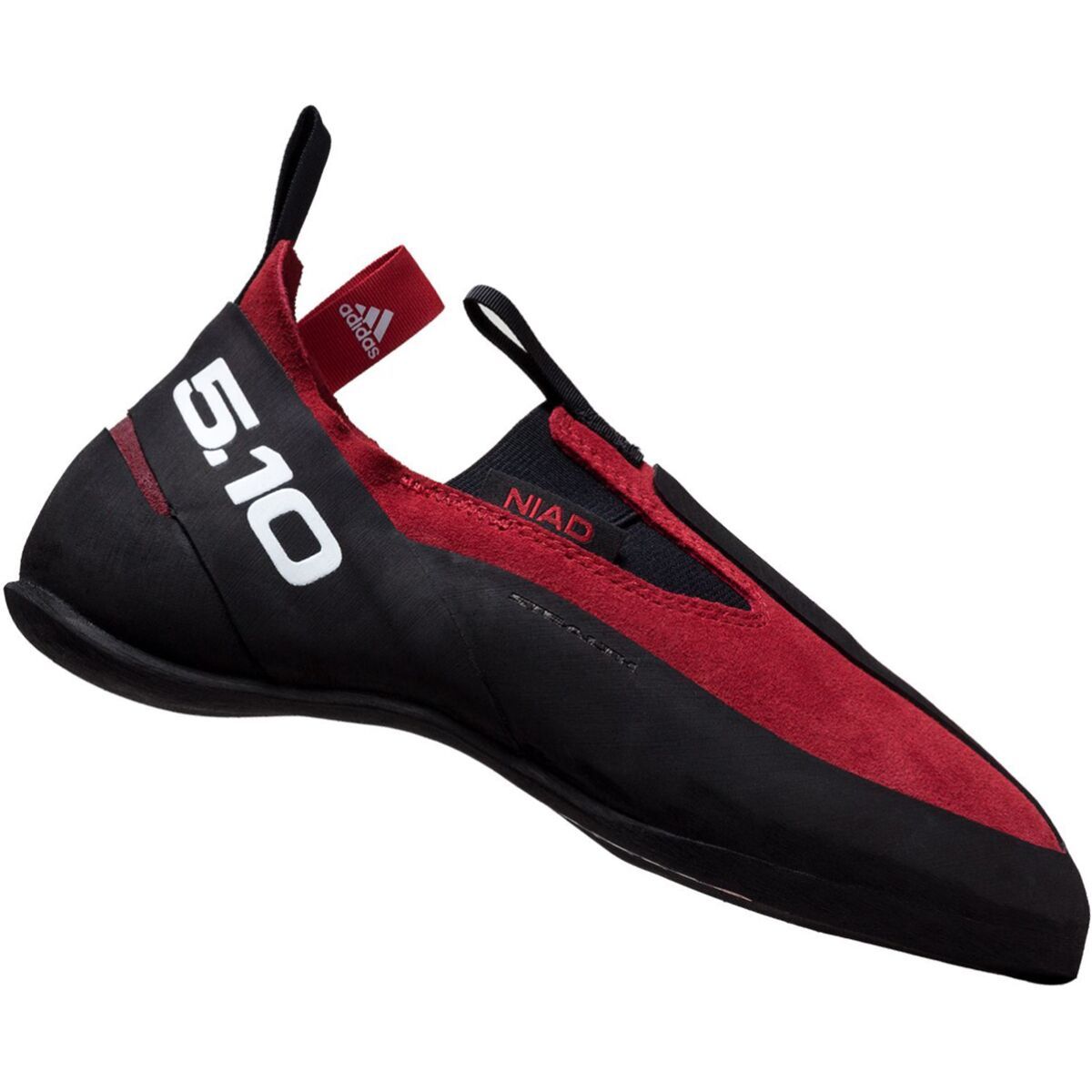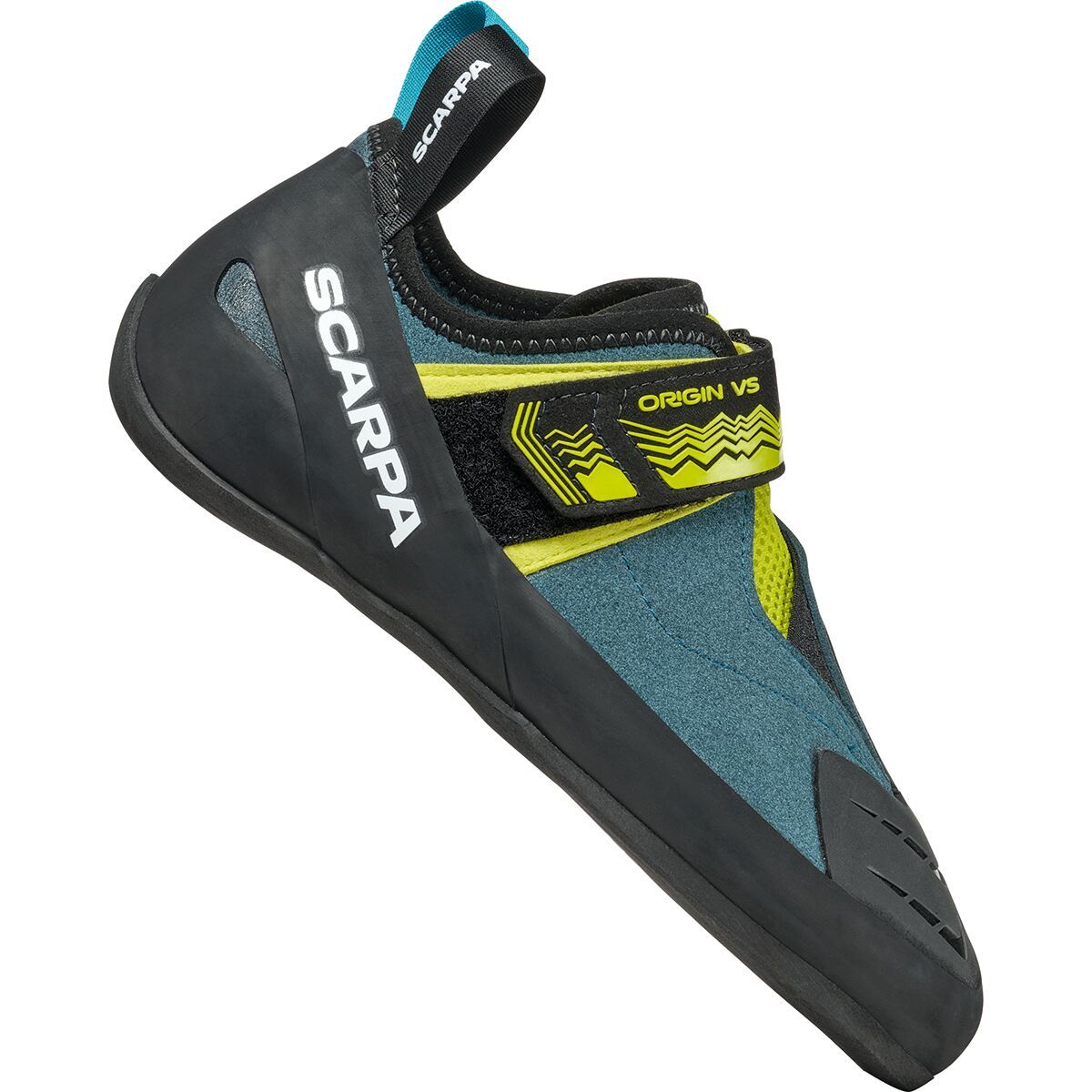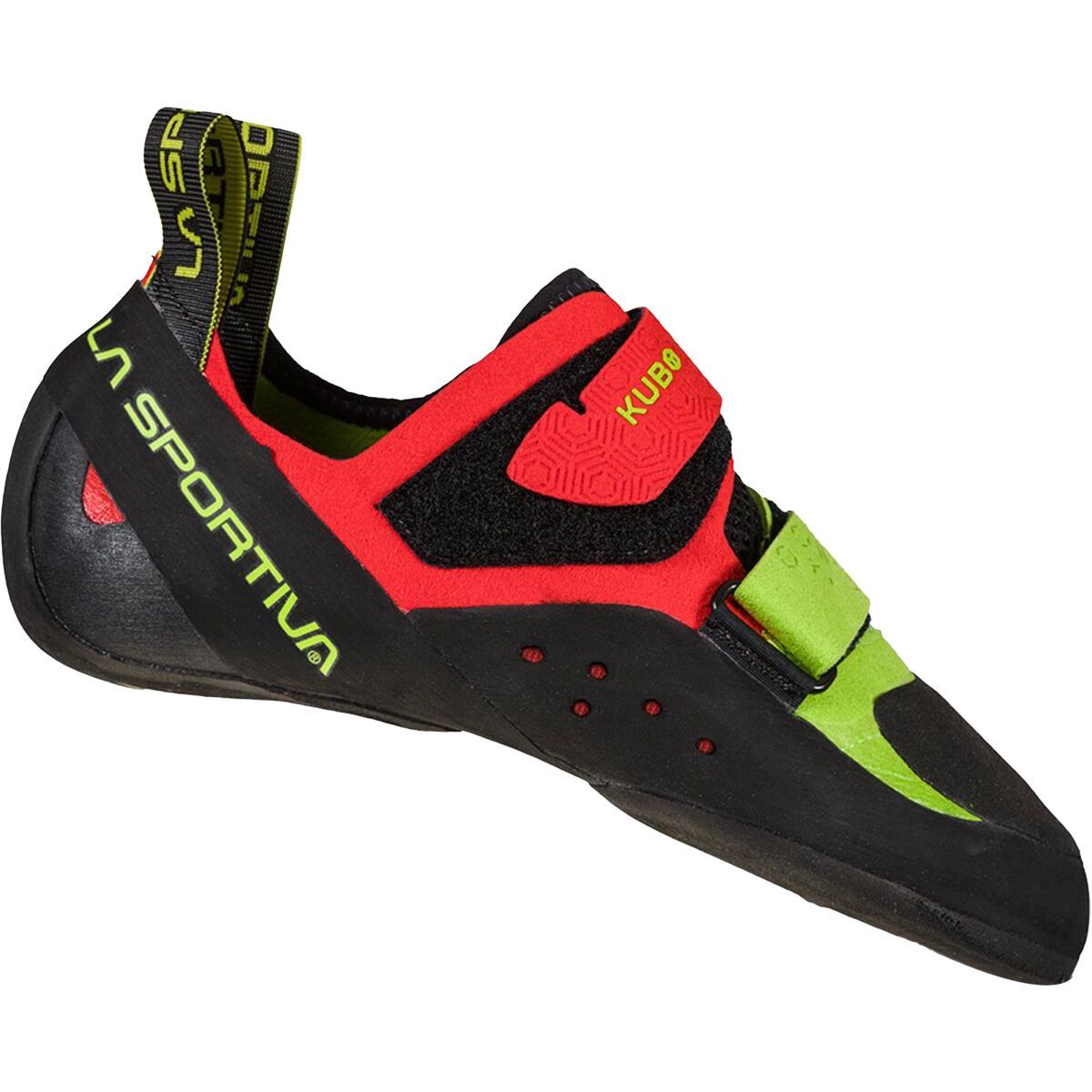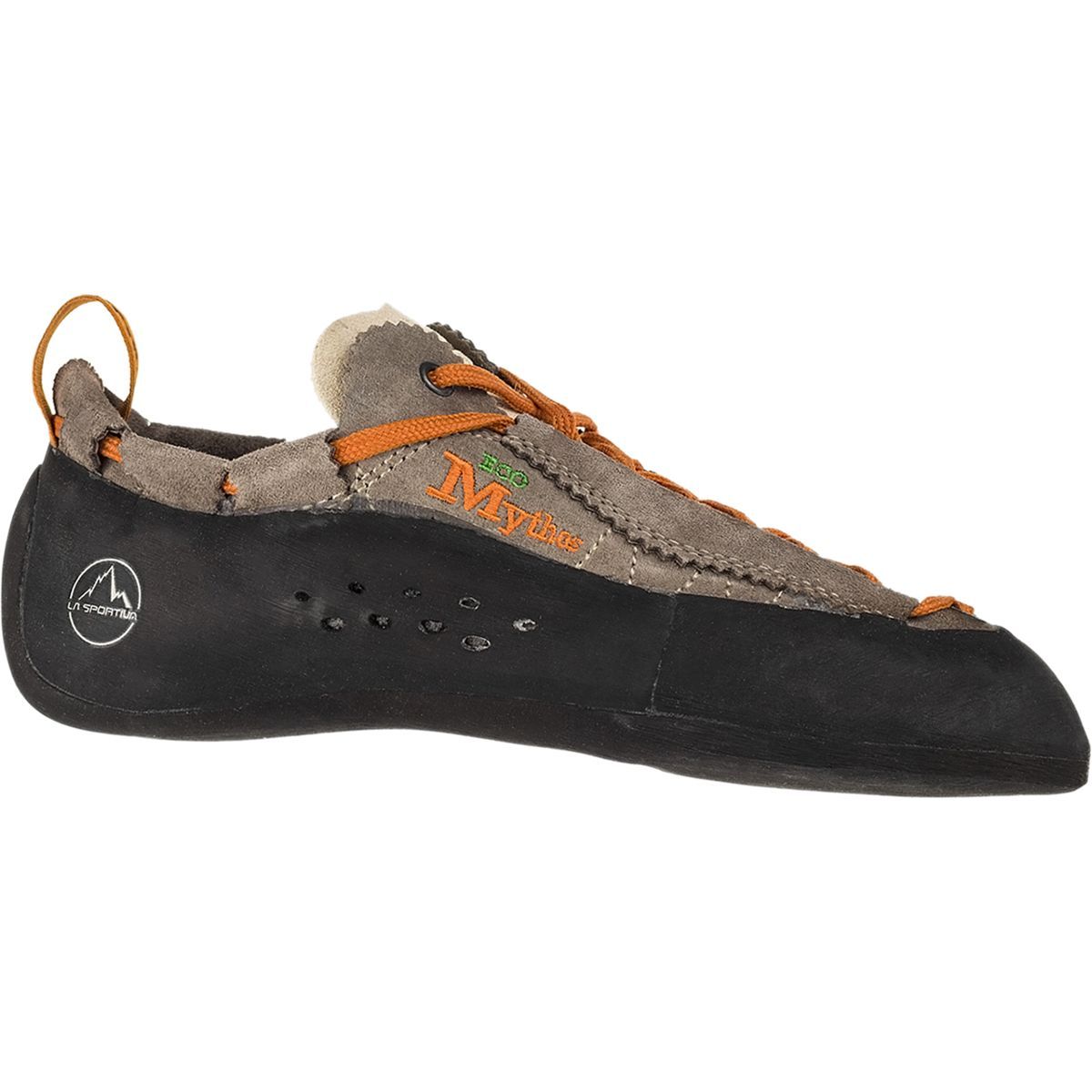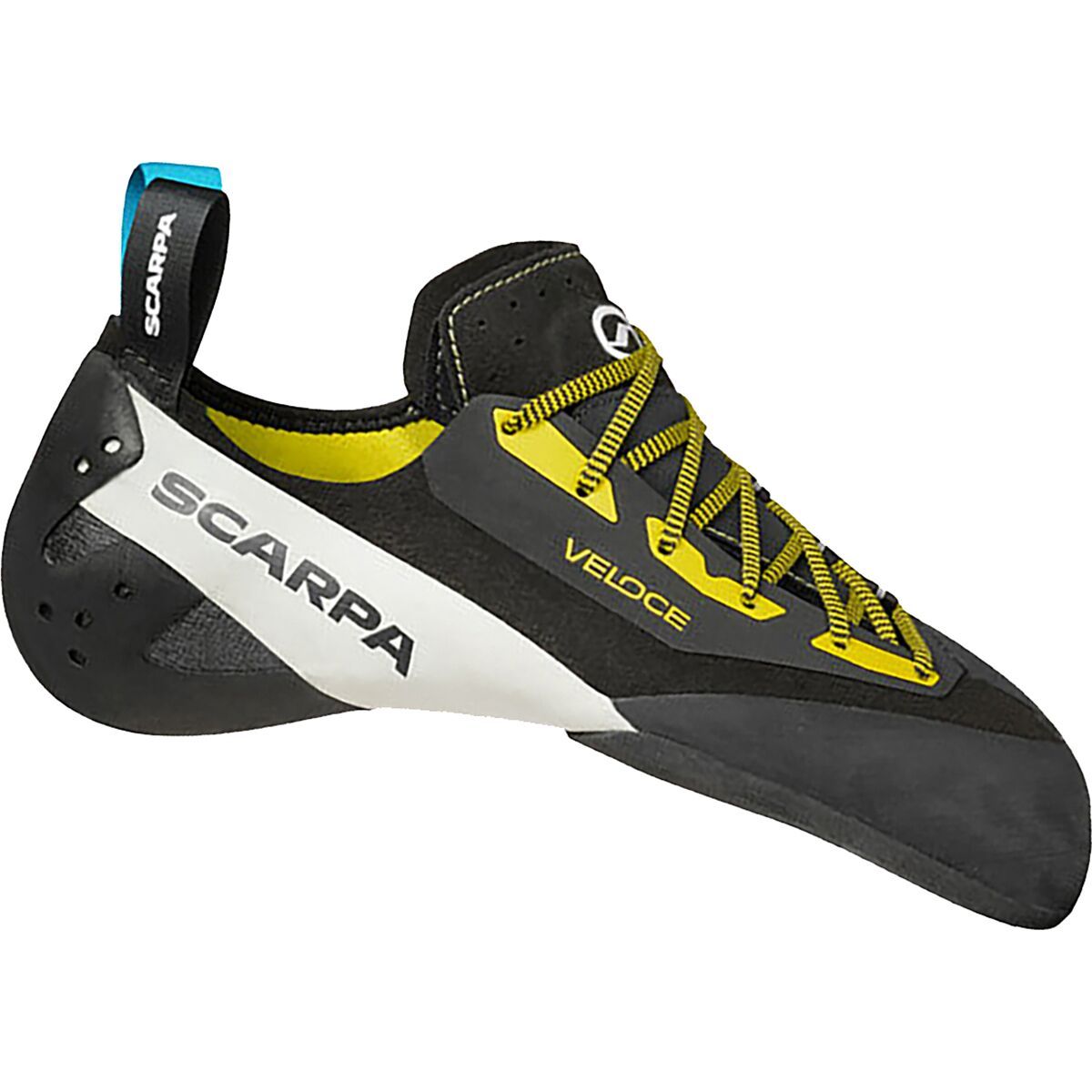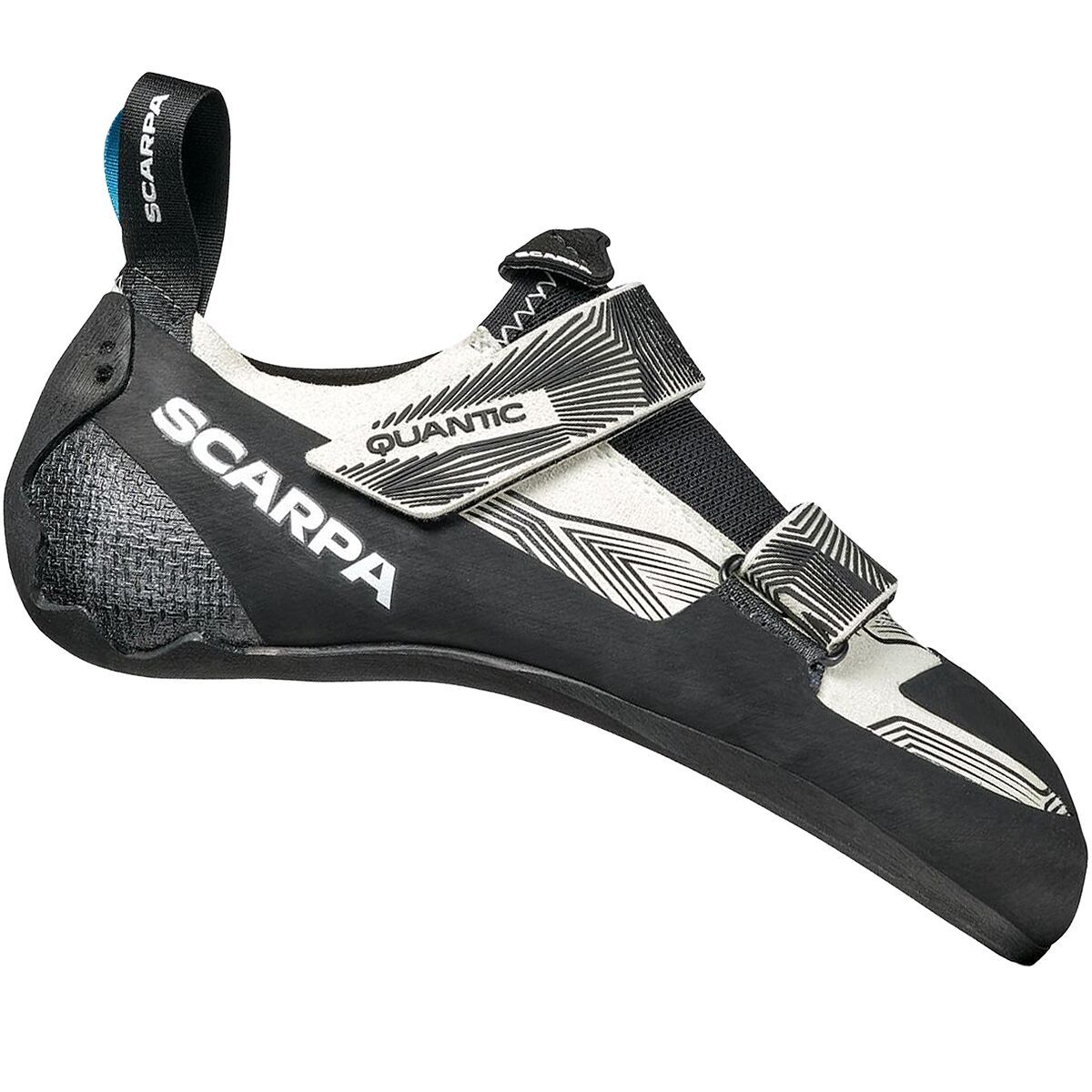If you buy through our links, we may earn an affiliate commission. This supports our mission to get more people active and outside.Learn about Outside Online's affiliate link policy
A Beginner's Guide to Climbing Shoes
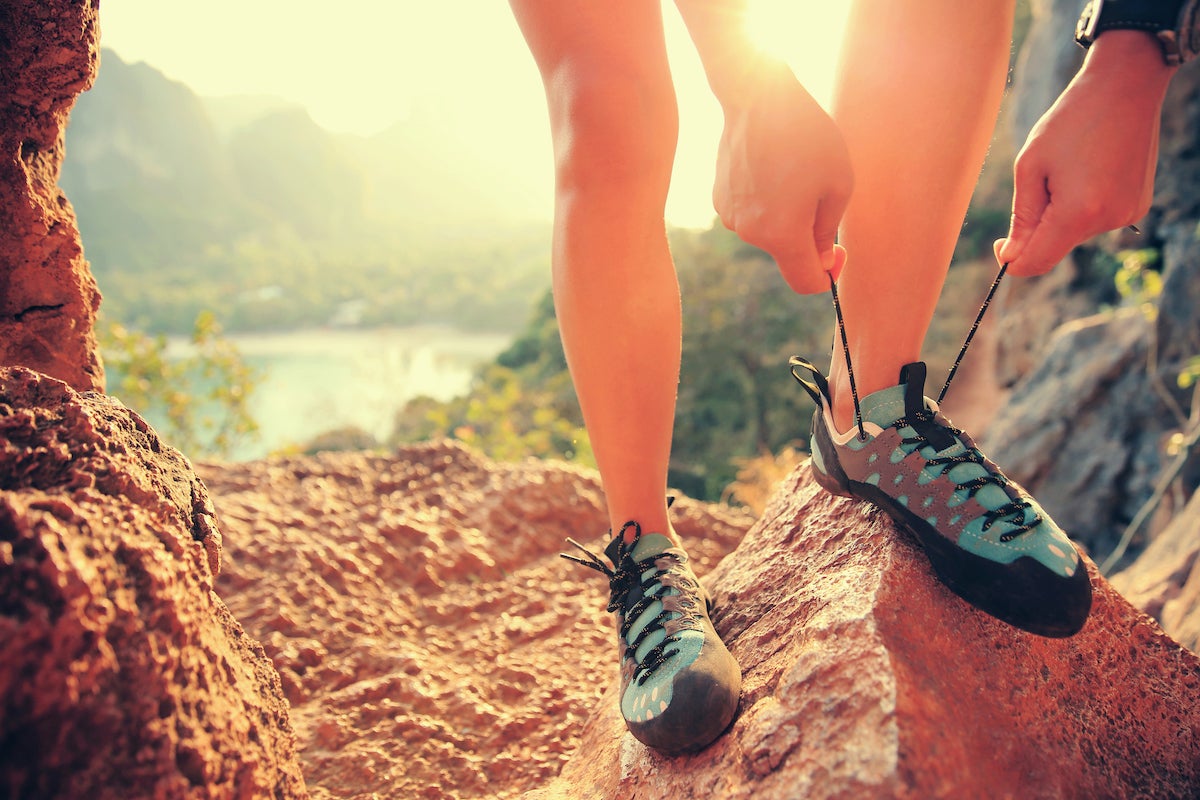
(Photo: lzf / Getty Images)
Table of Contents
Part 1. “You just wasted a hundred bucks, dude.”
On Columbus Day Weekend, 2004, my father took me to the Eastern Mountain Sports in West Lebanon, New Hampshire, to buy my first pair of climbing shoes. I was 15 years old and was not yet a “real climber.” Having toproped outside once and spent a few hours traversing my school’s wooden wall in my sneakers, I knew I was interested in climbing, but I had never led a route, never set foot in a commercial gym, and had no idea what terms like drop knee or heel hook or crimp meant.
The result? I stood before the shoe rack, perplexed by strange names like “Miura” and “Moccasym” and “Anasazi Velcro.” Aside from simple basics like color, I couldn’t tell the shoes apart and had no idea that some were stiff while others were soft, that some were aggressively downturned while others were flat, and that these different attributes made them excel at different aspects of the sport.
Eventually a lanky young shoe-salesman with blond dreadlocks stepped up and asked me what kind of climbing I wanted to do (“The adventure kind!” I replied), then helped me into a pair of Five Ten Asyms—blue ones, upturned in the front, stiff as boards.
Not knowing any better, I sized my Asyms like sneakers: snug but with enough spare room in the toe that I wouldn’t bruise my toenails when walking downhill and loose enough so that I could wear them with a pair of wool socks when it got cold. I was happy with them. Psyched. But when I returned to school on Monday and proudly showed them to the friend who’d just introduced me to climbing, he shook his head sadly.
“You just wasted a hundred bucks, dude,” he said.
“They’re tens!” I responded defensively. “Same size as my sneakers.”
“Try climbing in them,” my friend said. “You’ll see.”
I tried. They were about six-sizes too large and designed for long days on smear-intensive big walls, not bouldering indoors and sport climbing on steep schist. After five or six weeks of grumpy denial, I returned to EMS for my second pair of climbing shoes.
As it turns out, my experience was not unusual. Beginner climbers, like beginner cyclists and beginner backpackers, are often forced to make financial decisions without the kind of background knowledge that helps them make informed purchases. In hopes of saving a few of you from the mistakes that I made, I’ve put together this in-depth primer into climbing shoes. It’ll tell you everything you need to know about the different shapes and functions of climbing shoes, and makes some recommendations for a first-time pair.
If you buy through our links, we may earn an affiliate commission. This supports our mission to get more people active and outside. Learn more.
Part II. What do beginners need to know about climbing shoes?
Deciding what kind of shoe is best for you is a bit like trying to decide what kind of cake you’d choose if you could eat only one type of desert for the rest of your days. That’s because many climbing shoes are designed for specific styles of climbing. For steep roofs and caves, you want soft, aggressive shoes; for vertical granite you want stiffer, flatter shoes with great edging support; for cracks, something supple, flat, and bendy is ideal. “All-arounders” don’t truly exist in the world of performance climbing shoes, which is why most experienced cross-disciplinary climbers (climbers who trad climb, boulder, and sport climb, for instance) own multiple pairs. To complicate things, climbers also have different body types and climbing styles, both of which influence shoe decisions.
That said, you need to start somewhere. And since, as a beginner, you’re still learning (a) the basics of body position and footwork and (b) what kind of shoe will best compliment your climbing style, you’re better off going for a shoe that’ll perform adequately across disciplines and won’t break the bank. Once you’ve worked on your technique and learned to use your feet, you’ll be better able to appreciate the niche benefits of performance shoes and better equipped to make purchasing decisions.
Climbing shoes are complex, with shoe makers using a variety of tactics to allow, say, soft shoes to edge well, or stiff shoes to feel sensitive. But there are four general things you need to know about shoe design.
1. Flat Shoes vs. downturned shoes.
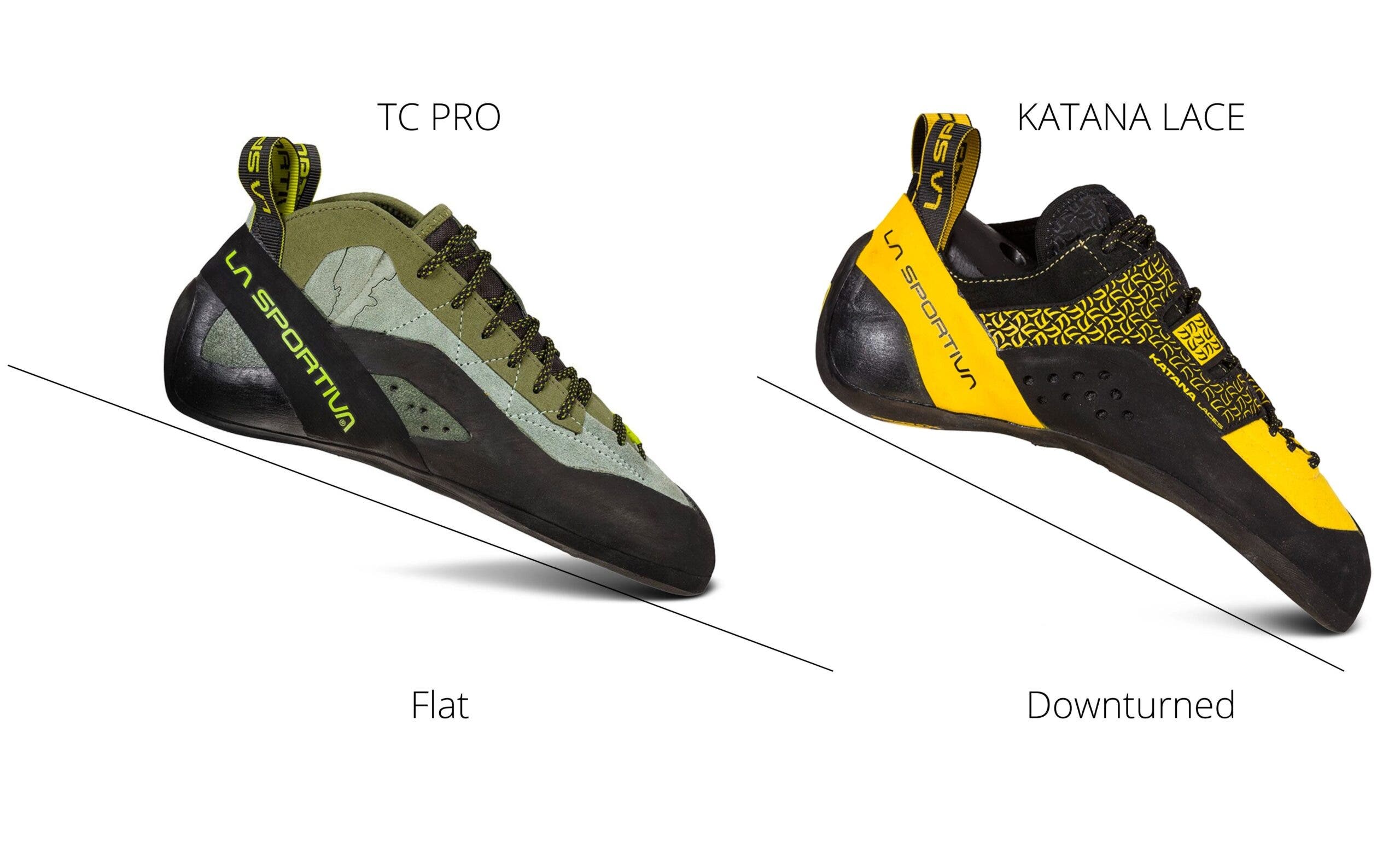
Flat shoes. Designed for slabs and vertical walls, where you’re often supporting most of your body weight from tiny edges that you stand on with your big toes, flat shoes are—as they sound—flat-soled. People generally size them so that their toes aren’t totally crumpled up (as they are in aggressively downturned shoes). Most flat shoes are pretty stiff—the stiffer they are, the easier it is to stand on tiny edges—but some, like the classic Five Ten Moccasym (listed below), are very soft, and their flexibility allows them to torque well into cracks and smear well on slabs. Because they’re often more comfortable, flat shoes are popular with beginners and kids—but they don’t provide great performance on steeper climbs, so if you intend to do a lot of gym bouldering, you might be better off going with a slightly downturned shoe.
Downturned shoes. Meant for overhanging climbs and channeling your foot’s power into your big toe, downturned shoes have a bird-beaked shape and are often (though certainly not always) pretty soft. Softness gives the climber more sensitivity in the toes, whereas stiffness provides support and makes it easier to generate power through the toes. Unless you exclusively climb on slabby or vertical terrain, you will eventually want a pair of downturned shoes.
Downturn ranges from slightly downturned to moderately downturned to aggressively downturned.
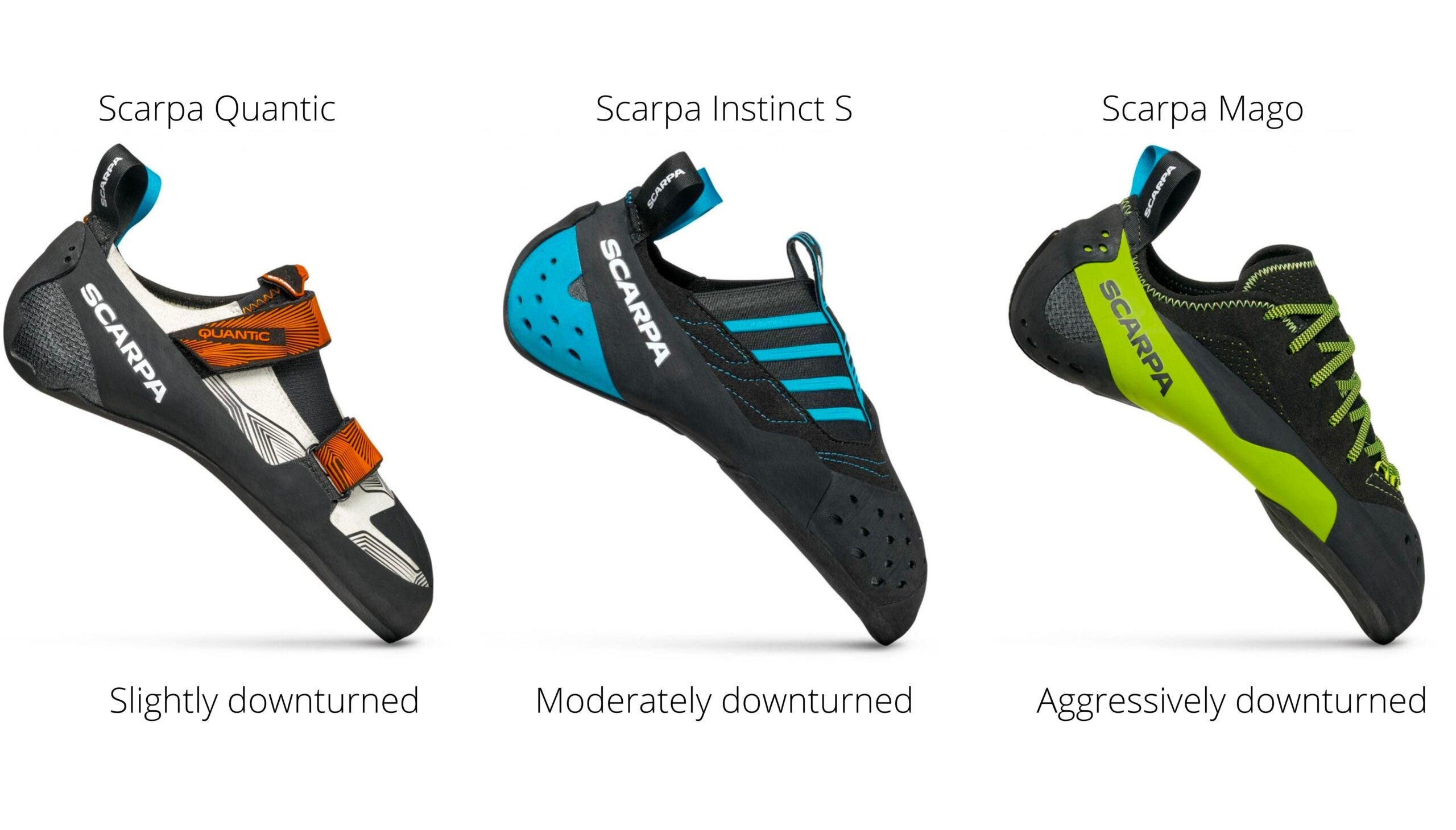
Slightly and moderately downturned shoes are workhorses—probably the closest thing to true all-arounders; stiffer ones (like the Muira VS, listed below) perform well on vertical terrain but can also toe into crimps and pockets on steeper walls; softer ones (like Scarpa’s Quantic and Veloce L, both also listed below) have the sensitivity to excel on smears while not sacrificing performance on steeper walls. Extremely downturned shoes, on the other hand, are more exclusively designed for toeing in on overhangs.
2. Stiff shoes vs. soft shoes
Stiff shoes can be either flat (like the TC Pro in the picture above) or downturned (like the Katana). Their rigid midsoles help support your foot, allowing you to stand on smaller holds and making it easier to generate power through your toes. There are two downsides to stiff shoes: (1) they’re harder to manipulate with your feet, (2) they lack the sensitivity (the ability to conform your shoe around what you’re standing on) of soft shoes.
Soft shoes, meanwhile, can also be either flat like the Five Ten Moccasym or downturned like Scarpa’s Veloce L. Soft, flat shoes are great for crack climbing, while soft downturned shoes are great for steep walls and indoor climbing, where smearing on volumes is commonly required. Neither excel at vertical edging.
3. Asymmetrical shoes
Just about all climbing shoes are a little asymmetrical, which which we mean that they skew medially, allowing you to drive more pressure (and therefor power) through the big toe. The more the tip of the shoe skews inwardly away from the center line, the more asymmetrical the shoe. Flat shoes are generally more symmetrical than downturned shoes. The purpose of the asymmetry is to keep your toes in a crimp position (scrunched up as in a ballet slipper), which helps you curl your toes over holds on steep routes and, with some models, helps support you on small holds on vertical terrain.
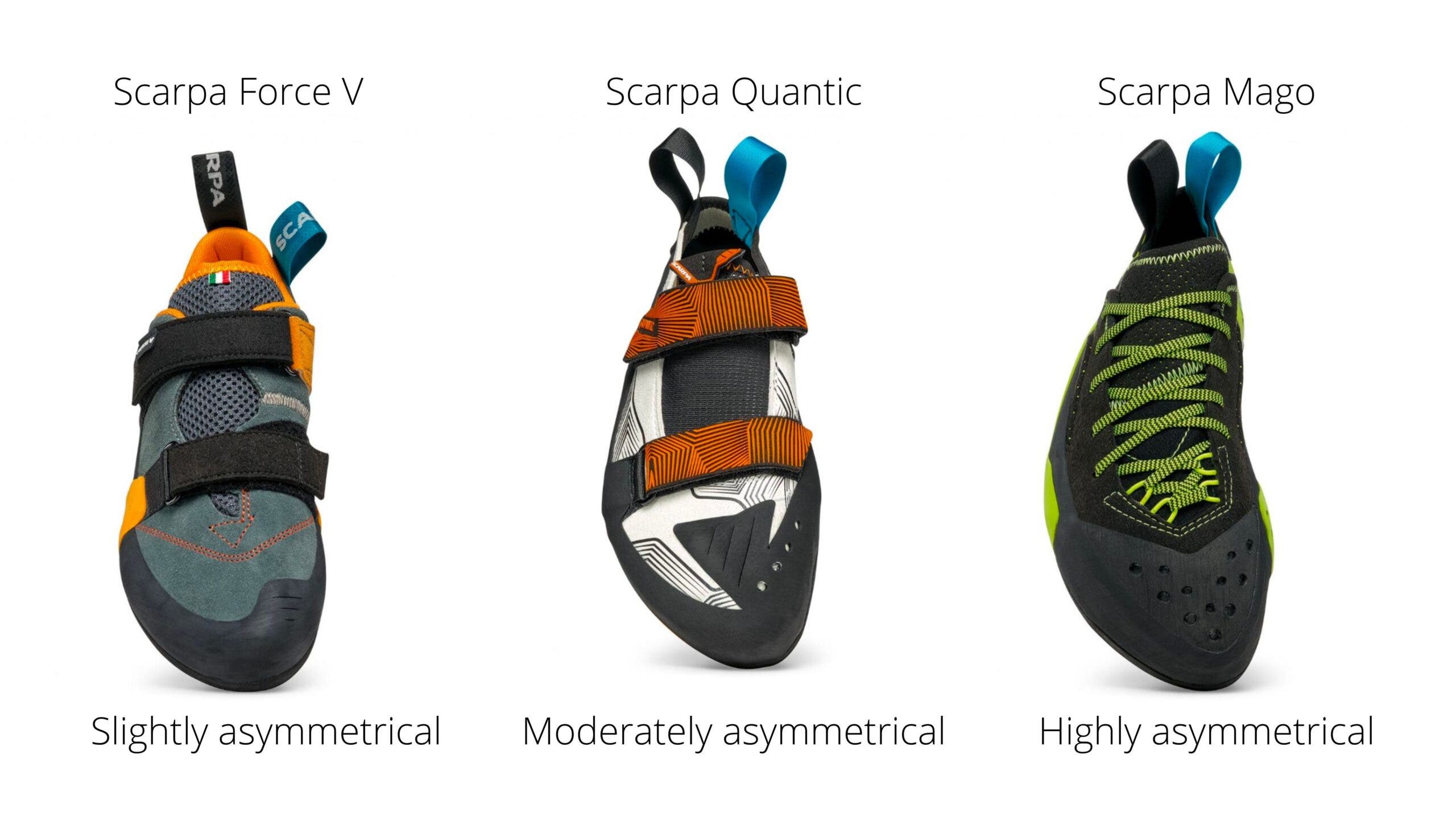
4. Closure Systems
Newer climbers are often surprised to learn that closure systems—generally divided into three categories: laces, Velcro, and slippers—are more than just a preferred way of fastening a climbing shoe to the foot; they actually change the nature of that shoe’s performance.
Laceups. Laceups allow the wearer to customize the way the shoe flexes or doesn’t. But they aren’t great for toe-hooking and they take longer to put on and take off.
Slippers. These tend to be soft and conform tightly to your feet. These shoes are generally good for gym climbing and steep boulders—and if they’re flat, for cracks—but they often do less well on slabbier and vertical terrain, where supported edging is the name of the game. The drawbacks: (1) you have to size them quite small because you can’t adjust them; (2) heelhook too aggressively and it’s pretty easy to pull your shoe off. This is why many newer slippers have a single high Velcro strap near the ankle.
Velcro. The benefit of Velcro: it’s more supportive and customizable than a slipper but easier to get on and off than a laceup. The drawback? These straps tend to get in the way when you’re toehooking—which is why a more slipper-like shoe is often preferable when intense toehooks are required. As a beginner, don’t worry about this drawback too much—but if you plan on doing most of your climbing in a gym, it’s worth considering.
Part III. Some FAQs about First-Time Shoes
What kind of shoe is right for me?
Generally speaking, A first-time shoe is doing its job if it allows you to have fun while learning the basics of footwork and body position. To maximize this learning process, find yourself a flat-ish shoe with plenty of midsole support and then size them down slightly off your street shoe: you want them to feel snug, maybe even a bit too snug, but not painful. Remember that all climbing shoes—and especially leather ones—stretch with wear. Shoes that fit perfectly when first purchased will feel a bit too big after a few weeks of use. In time, as you try various disciplines and hone your technique, you may want to upgrade to a shoe that’s specifically designed for the types of climbing you do. Boulderers might get a pair of uber-aggressive slippers; sport climbers might buy some aggressive yet supportive shoes equally suited to vertical edging and steeper walls; and trad climbers might go for shoes that twist well into cracks or edge well on long vertical terrain.
Want to learn more about what type of shoe is best for you, check out pro climber Paige Claassen’s excellent flowchart on this subject.
How should I size my shoes?
Many highly aggressive climbing shoes are designed to be sized uncomfortably tight, but as a beginner, discomfort is working to your disadvantage. You’ll improve faster if you can move around on rock (or plastic) without thinking about how painful your feet feel. That said, comfort isn’t king. Your first shoes should be just a bit too tight—and incomparably tighter than your street shoes. Your big toe should reach the very end of the toebox (tip: clip your nails short), but your toes shouldn’t curl all the way up unless you’re in a hyper-downturned shoe. If your toes are super scrunched, or if the arch of your foot is cramping, or if you’re feeling pins and needles in your feet, or if you can’t get your heel all the way down in the heelcup—well, if any of that’s happening, try a half-size larger until you have a snug fit that’s close to comfortable. There should not be air pockets under your arch or around your heel. Take note of the material. Leather shoes stretch more than synthetic materials. Shoes with rubber strips over the top of the shoe stretch less than shoes without them.
(Note that things are different with many performance shoes, which can take some wrangling to get into. Your foot may not drop all the way into the heelcup during initial break-in phase. And you might not be able to get them on without feeling like you’re about to bust a tendon yanking on the pull tabs. These shoes are not great for beginners and often require an extended break in period, often involving chilling on the couch in your shoes trying to stretch them out.)
How much money should I spend?
The shoes listed below range in price from $89 to $199—which is relatively cheap as far as climbing shoes go. But when thinking about how much you want to spend on your first pair of climbing shoes, here are a few things to consider:
You don’t need a sports car. Giving a pair of hyper-aggressive $200 bouldering slippers to a beginner is a bit like giving a Ferrari to newly licensed 16-year-old: You’re likely to climb holes into your soles long before you accrue the skills required to fully take advantage of the shoes.
Your first shoe might not last you very long. The longevity of your climbing shoes largely reflects the type of climbing you’re doing—real rock is more abrasive than plastic; sharply striated schist is more abrasive than glacially polished granite; plastic is less abrasive than everything—and… the quality of your footwork. For this reason, most beginners are better off starting out with a cheaper shoe that they can learn on without worrying too much about the price tag.
That said…
You will progress beyond your first shoe. Most beginners don’t stay beginners, and this means that many climbers advance beyond the functionality of their first climbing shoes long before those shoes break down. For this reason, if you think that climbing might become a consistent part of your weekly schedule, it’s not a bad idea to do one of two things: either (a) shop sales and buy a cheap (or even used) first pair of shoes with the knowledge that you’ll probably want to buy a sleeker shoe in the near future; or (b) spend a little bit more money and get a pair of shoes that you can progress into. Then focus on improving your footwork.
What are the five most common mistakes beginners make when purchasing their first climbing shoes?
- Wearing socks. Climbing shoes aren’t meant to be worn with socks. The shoes should be far too tight for that. Yes, there are some very strong climbers who sometimes do. But by and large this is a mistake.
- Sizing for comfort. Though foot discomfort is not a virtuous end-unto-itself (as some climbers believe), comfort isn’t the chief metric with which you should purchase climbing shoes. Instead, think about what kind of climbing you want to do and what type of body and foot type you have. A comfortable climbing shoe still isn’t something you’ll want to wear for a full two-hour session.
- Buying the cheapest shoe. If you’re a beginner and don’t know how much climbing you’ll actually do, it makes sense to buy a cheaper shoe. But if you’ve climbed enough to know that climbing might become an important part of your life, you’re probably better off taking the time to find a more intermediate pair of climbing shoes that you can grow into—and this will require spending some money.
- Buying the most expensive shoe. When you first start climbing, your footwork is (alas) going to be terrible. And terrible footwork (double alas) often decreases the lifetime of your shoe. Beginners can plan on wearing through their first pair of shoes far faster than more advanced climbers, so you’re better off getting a cheaper shoe and working on your technique before forking over $200+.
- Listening to the store clerk who does not climb. Remember my sorry tale from 2004? Well, it’s a common one. While your random outdoor gear store employee in 2024 is far more likely to have rock climbed than they were in 2004, it’s still probably prudent to ask the salesperson how much climbing they’ve done, and what kind, when purchasing shoes. If they don’t have much experience, don’t treat their word as bible. (Chances are that your local climbing gym sells shoes; the 16-year-old kid with huge forearms and baggy clothes is probably the best resource in your town.)
Check out this article, “The Rock Shoe Bible” by Climbing’s former Editor-in-Chief, Matt Samet, to learn more about shoe terminology, sizing, and history.
Part IV. The Best Shoes for Beginners
A note about organization: the shoes below are organized low to high by price. This is not the same as saying they’re organized low to high by performance, but there are some correlations. The shoes down at the bottom of this list are probably best described as intermediate shoes—and they can (and are) worn by advanced climbers—but I believe they can also serve beginner climbers well.
La Sportiva Tarantulace
The cheapest shoe on this list—and, consequently, one of the best-selling climbing shoes in the U.S.—the Tarantulace is a comfort-first shoe with an unlined leather upper, a mildly asymmetric shape, a stiff last, and a relatively roomy toe-box. The uppers are leather, so they’ll stretch with time, and the soles are thick (5mm of FriXion rubber), which increases the chance that you’ll learn good footwork before burning all the way through the rubber.
Should you buy this shoe?
If you’re buying shoes to go up big walls, prioritizing all-day comfort and durability makes sense. But these attributes come at the direct expense of performance. The Tarantulace’s stiff toebox is famously insensitive, making it hard to feel the things you’re standing on. And the stiff, flat last hurts its performance on steeper walls.
So if you, like most beginners, anticipate (a) bouldering in the gym, or (b) sport climbing outside, I strongly recommend opting for something a bit more performance oriented. This shoe is essentially the modern day version of the Five Ten Asym that I purchased oh so long ago.
Why did I include it? Because it’s cheap. And there’s value to that.
Pros: price, durability, decent performance on less-steep outdoor walls.
Cons: insensitive and unversatile, with limited performance on steeper climbs. Not a shoe that will grow with you.
Black Diamond Momentum
A classic beginner shoe for those wanting an all-around, comfortable, quality shoe, at a good price point, with sound construction. As our reviewer noted: “For a beginner climber, the Momentum is excellent, and with a tag of $99.95, the price is right. The shoes have enough performance to take you from 5.6 to 5.11 on any type of route, and, for a soft, slipper-like flat last, they edge decently, mainly due to the rather straight profile on the inside of the shoe, which lets your big toe do all the work. Because of a nice long arch on the outside rand, the backstepping ability of the shoe is generous.”
The con? Unlike a new generation of beginner shoes,the Momentum is not designed with indoor climbing specifically in mind. It does not have top-of-the-toe rubber—something beginners in bouldering gyms will begin to value within just a few months of starting—and it doesn’t perform as well on the steeps.
In sum: a great shoe that you’ll quickly grow out of.
Fit: our reviewer fit the Momentum in his street-shoe size and it was spot on.
Scarpa Reflex V
The Reflex V is a flat-lasted Velcro designed for all day wear. A sturdy, well-made shoe with two Velcro straps, the Reflex V has leather uppers that conform to your foot plus a solid, symmetric footbed that ensures a relaxed feel. The Reflex V doesn’t perform remarkably well on tiny holds or overhangs; nor do they have much sensitivity or edging power; so beginners who aspire to progress quickly through the grades would do well to pick a more aggressive shoe to start with. But if value and comfort are your priorities, these kicks are a great choice.
Evolv Defy & Elektra
The Defy (and its women’s version, the Elektra) is a remarkably comfortable shoe that provides decent beginner performance for jamming, smearing, and edging. With a perforated, synthetic upper, nylon lining, and padded tongue, it almost feels like you’re wearing socks. The flat, slightly asymmetric last is soft and sensitive, yet a half-midsole provides some edging power.
Like most all-day shoes, the Defy doesn’t excel at anything, and if you’re planning on making climbing a real part of your life (and if you’re comfortable shelling out an extra $25-100 for something that will eventually wear out) I’d recommend going for a “fancier” shoe. But they are comfortable, and they’re cheapish, and they do the job.
What are they best at? Speed climbs! The Evolve Defy is the shoe of choice for Olympic Speed Climbing bronze medalist—and world recorder holder—Sam Watson. And it was therefor included on our 12 Climbing Shoes From the Paris Olympics.
Butora Endeavor
As the one-stop shop of Butora’s shoe line, the Endeavor is a durable, medium-stiff, medium-flex, sticky-rubber kick that is at home on vertical, slabby, and even slightly overhanging terrain. The Endeavor provides great performance without requiring downsizing (i.e. pain). The low-ish price makes this an excellent option for a beginner gym or mileage shoe. Although, as with most shoes on this list, our reviewer notes that the Endeavor, though good at everything, doesn’t particularly excel at anything.
Pros: Well-rounded performance. Multiple fit options: comes in both wide and narrow fits. Odor-blocking hemp lining.
Cons: Doesn’t perform well on steeper climbs requiring “grabbing” with the toes.
Five Ten Niad Moccasym
For decades, the Five Ten Moccasym has been the shoe of choice for elite crack climbers, but it’s also a great beginner shoe. (I went through three pairs of the Moccasym in my first five years of climbing—wearing them on warmups and during gym training sessions. The Moccasyms have a soft flat rand that’s great for smearing and torquing into cracks. Recent updates to the shoe (rubber over the big toe) make it more functional for beginners likely to climb in the gym. Note: these shoes stretch a lot once you start breaking them in, so make sure you size them a little snug.
Origin VS (New!)
Scarpa’s new Origin VS is part of a relatively new genus of rock shoe: a “gym-focused all-arounder.” As such, it’s less like a Ferrari than a Subaru Crosstrek: comfortable, functional, designed to perform equally well in a variety of daily climbing situations. I’ve been testing the Origin VS for the last two months (longform review forthcoming), and I confess that, on session one, I was a bit underwhelmed, so I switched into a more advanced pair of shoes after my warm up. But over the next few days, as the shoes broke in, I found myself wearing the Origin VS deeper and deeper into each session. And during my most recent gym session, I simply never switched out of them. What I liked about the origin, first and foremost, is the comfort. I sized mine quite small, but I still found myself forgetting to take them off. And yet the closure system—a single velcro strap over a padded tongue—makes them incredibly easy to put on and take off, something that shouldn’t be taken for granted in climbing shoes. But the Origin also performed well. It’s soft enough to “grab” on steep climbs or smear on volumes but stiff enough (it has a full-length mid-sole) to smedge well on slabs.
It is not, however, quite so versatile outdoors. I wore the Origin outdoors only twice—both times while developing a new gneiss boulder field in the Adirondack Mountains—and found that the S72 rubber is softer than the shoe’s structure. I’d step on a small edge, feeling comfortable and supported by the full-length mid-sole, only to have the soft, S72 toe rubber literally tear under the focused pressure of the rock.
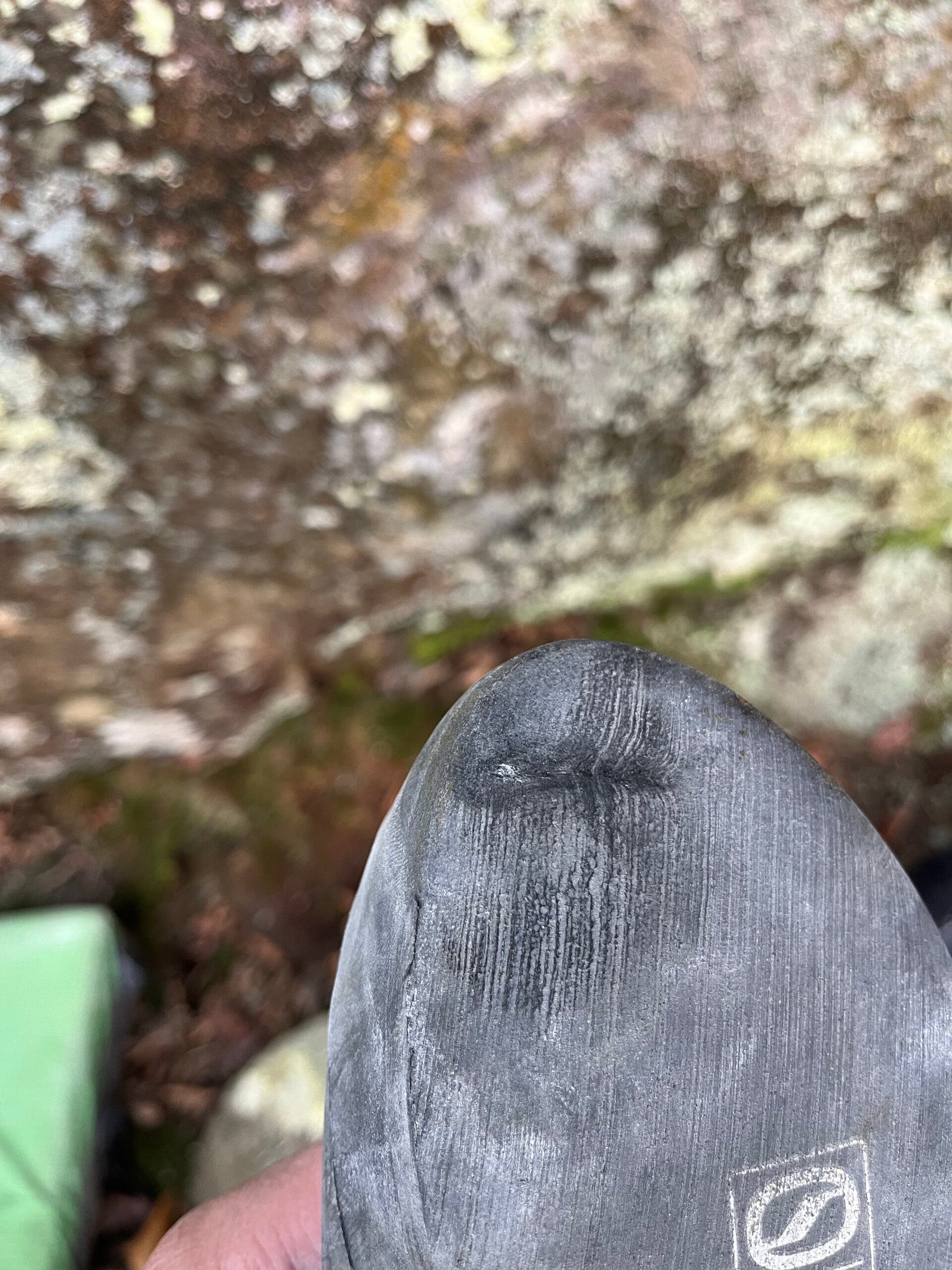
In sum: I consider the Origin the single compromise on this list. It’s cheap, it’s comfortable, it’s good at literally everything you need a gym shoe to be good for, and it’s capable of seeing you up far more advanced boulders or routes. Thought slightly more experienced climbers can use it as an all-day training shoe, I’m going to be honest: if you’re already climbing V5 or 5.12, or if you plan to also wear the shoe outside, I’d recommend shelling out for something a little bit more advanced.
La Sportiva Kubo
Moderately asymmetrical and moderately downturned, the Kubo is designed for intermediate climbers who value comfort and versatility—which is basically what beginners should be looking for in a shoe. I’ve not worn the Kubo myself, but they come recommended from a close friend of mine, who’s been climbing for five years and has sent multiple V7s and led 5.11 outside. As a plus: unlike traditional beginner shoes, which were no frills, these shoes recognize that most climbers climb in the gym, where toe-hooking is common, so they have an ample top-of-the-toe rubber patch.
The cons? First, the Kubo is a bit pricier than most true beginner models. Second, versatility comes at the expense of specialization: this shoe is great if you’re interested in doing it all, but if you’re specializing in a discipline, you might be better off getting a more focused shoe. Third, the thinner rubber (4mm) gives the shoe more sensitivity but means that it’ll wear down faster—unless you’ve already got good footwork.
La Sportiva Mythos Eco
Since 1991, the Mythos has been a genre-bending climbing shoe. In those 15 years, climbers have used the comfortable shoe for every style of climbing from boulders to plastic. Several years ago, La Sportiva gave the Mythos a green upgrade, turning it into the Mythos Eco. The shoe is made from 95% recycled components—the rubber is basically made from rubber floor scraps—but, aside from earthy colors, its performance is indistinguishable from the original shoe.
How does it perform? The Mythos is stiff at first, but that first impression is misleading. Climb in the shoe and it softens, eventually reaching a stasis where it still has enough stability to edge but is soft and sensitive enough to feel out micro bumps. A former editor here did the first ascents of numerous 5.14s wearing the Mythos, pushing off insecure nothings as if they were ladder rungs. And Alexander Huber wore the Mythos on his famous free solo of The Communist (5.14a) back in 2004. So yeah: They’re good shoes. (Read our review.)
Scarpa Veloce Lace (New!)
I’ve been wrestling rocks real and fake for 20 years, and the Veloce L is one of my favorite climbing ever—literally the only shoe on this list that, when it wears out, I might actually go out and replace despite the fact that I’ve got a surprisingly burdensome stream of new products to test each month.
The Veloce L is a very soft shoe—the softest on this list—which, Scarpa says, is actually what the modern beginner wants. Back when beginners started climbing on ropes—toproping outside or in the gym— stiffer, flatter shoes like the Tarantulace made sense. But nowadays most climbers start inside, and most of them focus on bouldering, which means that it’s time to re-define what actually makes a good beginners shoe. What makes a good gym bouldering shoe? A soft shoe, good for smearing and steep climbing, that can be worn for marathon sessions. The funny thing about this, though is that those same qualities make for dang good outdoor shoes, too, at least in certain contexts. I loved the Veloce L on everything steep and/or smeary—from board and volume climbs in the gym to limestone caves, vertical cobble climbs, and steep basalt sport routes. Of course, if you’re looking for edging performance—i.e. if you plan on climbing outside on granite or vertical climbs—run like the wind away from this shoe.
For more details about what makes the shoe so awesome, check out my full review: Scarpa’s Newest Shoe Made me Feel Like a Con Artist
Scarpa Quantic
The Quantic is a soft, indoor-focused all-arounder that does everything laudably well, is comfy and light (13.4 ounces, size 40.5), and given its softness (epic smearing!) does almost better in the gym than on rock. The last is relaxed but pointy and precise—and the shoes are sensitive and excel on slightly overhanging terrain. For vertical or slabby micro-edging in, you might want something stiffer. These were built by legendary Scarpa shoe designer Heinz Mariacher with the intention of offering “a multi-purpose performance shoe, a mix of lightness, sensitivity, and good precision,” representing a step up into more advanced footwear for newer or intermediate climbers.
Want something just a bit stiffer? I personally preferred the Quantix SF, which I considered the best all-arounder of 2022.
Part V. Leveling up
The following shoes are examples of more intermediate / advanced models that could also prove suitable for first-time shoe buyers. This is, as above, far from a complete list.
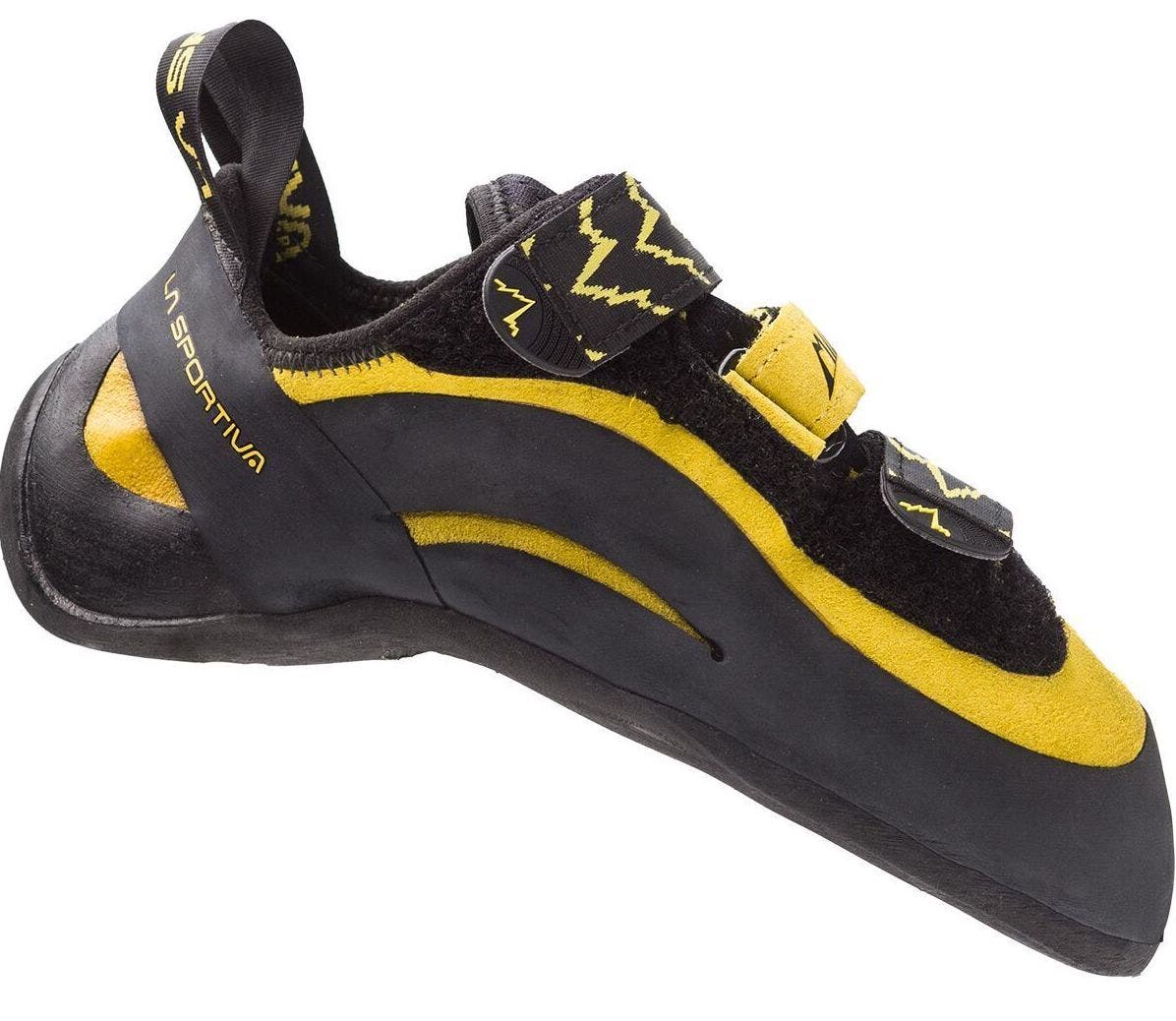
La Sportiva Muira VS
A “high performance” shoe that excels across disciplines, the Muria VS has become a go-to for beginners and experts alike. (Watch this video of elite British tradster Hazel Findlay styling a dangerous 5.13c in her Muiras.) As one of our early reviewers noted, the Muira VS is an all-around tool that will “improve every climber’s performance, no matter what discipline they are into… [it] just works well in all climbing applications. Who wouldn’t want that?” It excels on dime-edges, heel hooks, and finger cracks—but is also downturned and soft enough to do well on steeper terrain. The shoe does stretch (it’s a leather upper) but not excessively. Size it tight—but not insanely so.
Features: It has La Sportival’s patented P3 midsole, an asymmetric and downturned last, Dentex lining (no lining underfoot), leather upper, and 4mm Vibram XS Grip2 rubber, and three Velcro straps that attach in opposite directions, wrapping the shoe to the shape of your foot. Also available in a low-volume / women’s version.
The Miura VS got a light upgrade in 2023, and I reviewed it. What changed? Delightfully little.
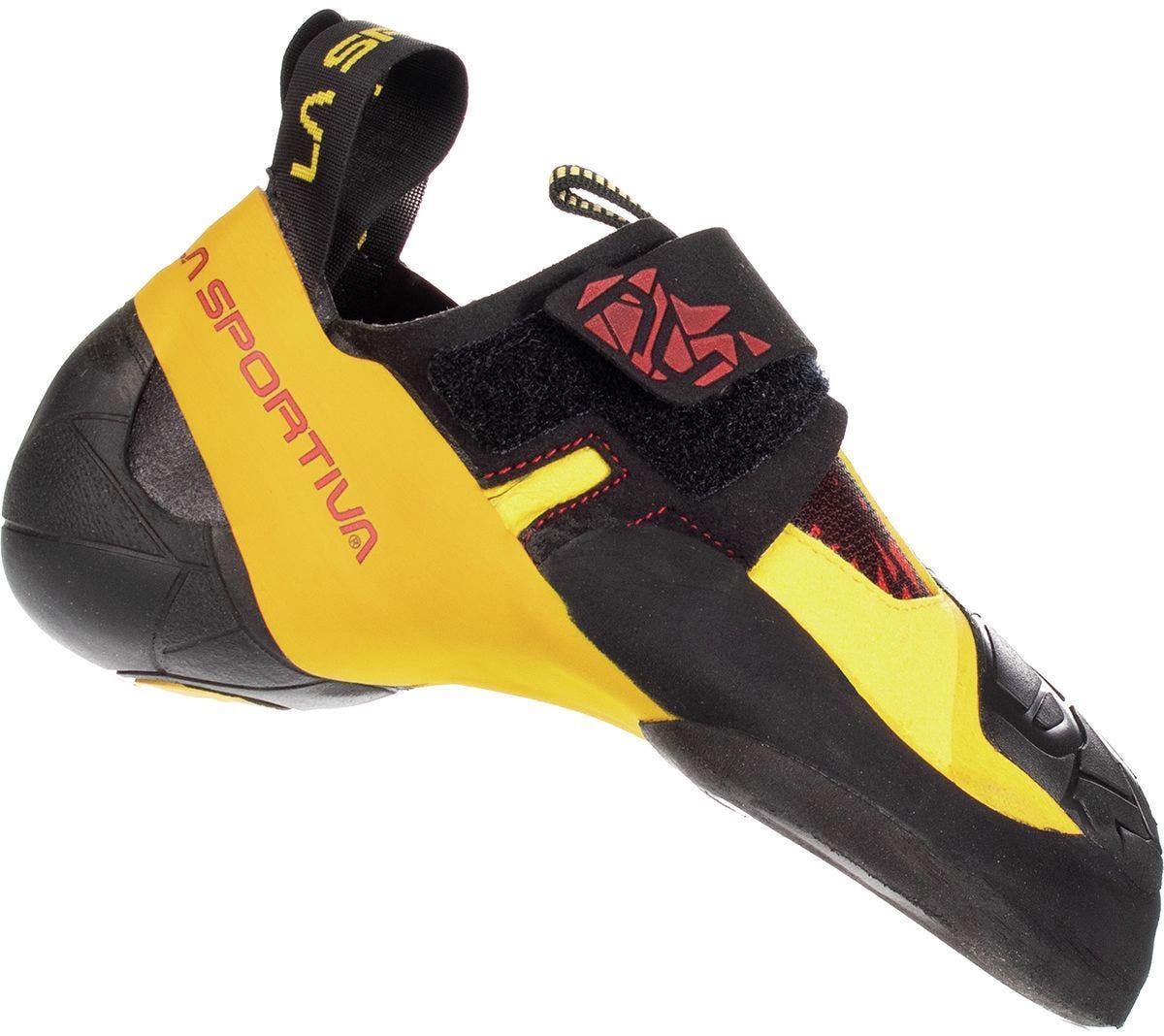
La Sportiva Skwama
Winner of the editor’s choice award in 2017, our editors described the Skwama thus: “These shoes are sort of the paradox of the high-end shoe world: elite performance but comfortable to wear; easy to get on in a slipper design, stiff for toeing-in but soft and sensitive for smearing.” A true all-arounder that (depending on how you size them) can excel on boulders and sport routes, edgy face climbs, crack climbs, comp boulders, or lazy jaunts up the big walls, the Skwama is a high-performance slipper hybrid that truly delivers as a sensitive and powerful shoe with a slightly lower price tag and higher comfort factor than many in its class.
The only complaint? These are performance shoes: they require two or three sessions (at minimum) to break in. (Read the full review here.)
